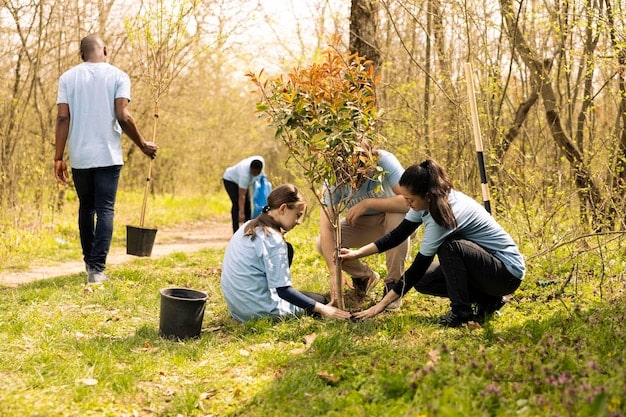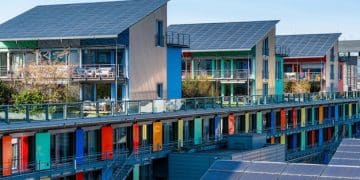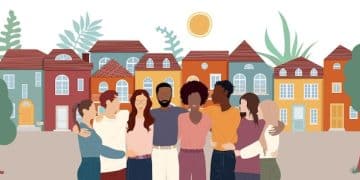Investing in Local Resources: Building Stronger US Communities

Building stronger communities in the US involves strategic investment in local resources, fostering economic growth, improving social well-being, and enhancing community resilience through various initiatives.
In the United States, the strength of the nation is deeply rooted in the vitality of its local communities. Building stronger communities: The impact of investing in local resources is crucial for fostering sustainable growth and improving the quality of life for residents across the country.
Understanding Community Resources
Community resources encompass a wide array of assets, services, and programs available within a specific geographic area. These resources are integral to supporting the well-being and development of local residents.
Investing in community resources means allocating funds, time, and effort to strengthen these essential components of a community. This investment can take various forms, including financial support, infrastructure development, and human capital enhancement.
Types of Community Resources
Community resources can be broadly categorized into several types, each playing a unique role in enhancing community life.
- Economic Resources: These include local businesses, financial institutions, and employment opportunities that drive economic growth and stability.
- Social Resources: These consist of social services, community centers, and support groups that promote social interaction and address social needs.
- Educational Resources: Schools, libraries, and vocational training centers provide opportunities for learning and skill development.
- Health Resources: Hospitals, clinics, and wellness programs ensure access to healthcare services and promote healthy lifestyles.

By effectively utilizing and investing in these resources, communities can create a supportive environment that fosters growth, resilience, and overall well-being for all residents.
The Economic Impact of Local Investment
Investing in local resources has a significant economic impact on communities. When local businesses thrive, they create jobs, generate tax revenue, and stimulate economic activity.
Supporting local entrepreneurs and small businesses can lead to increased innovation, competition, and economic diversification.
Job Creation and Economic Growth
Local businesses are often the primary drivers of job creation in a community. They tend to hire local residents and invest in their employees’ training and development.
Moreover, a thriving local economy attracts new businesses and residents, further boosting economic growth.
Multiplier Effect of Local Spending
When residents spend their money at local businesses, a larger portion of that money stays within the community.
- Increased Local Revenue: Local businesses are more likely to use local suppliers and service providers, creating a ripple effect that benefits the entire community.
- Tax Revenue: The increased economic activity generates more tax revenue for local governments, which can be used to fund public services and infrastructure projects.
- Community Development: The money stays in the community, supporting local organizations and initiatives, and enriching the overall quality of life.
By fostering a strong local economy, communities can become more resilient to economic downturns and better equipped to address local needs.
Enhancing Social Well-being Through Community Resources
Community resources play a vital role in enhancing the social well-being of residents. By providing access to essential services and support networks, these resources help to create a more inclusive and equitable society.
Investing in social programs and community centers can improve outcomes related to education, health, and crime reduction.
Access to Social Services
Social services such as counseling, job training, and childcare programs are essential for supporting vulnerable populations and promoting self-sufficiency.
These services can help individuals overcome barriers to employment, education, and social inclusion.
Building Social Connections
Community centers, libraries, and parks provide opportunities for residents to connect with one another and build social relationships.
- Community Events: Participating in community events and activities fosters a sense of belonging and strengthens social bonds.
- Volunteer Opportunities: Getting involved in volunteer work helps people develop new skills, meet new friends, and contribute to the well-being of their community.
- Support Programs: Participating in social and support programs that foster inclusivity and community support.
Strong social connections can reduce social isolation, improve mental health, and enhance overall quality of life.

Investing in Education and Skill Development
Education and skill development are critical for the long-term success of individuals and communities. Investing in educational resources can improve educational attainment, increase employment opportunities, and promote economic mobility.
Local schools, libraries, and vocational training centers are essential components of a strong educational ecosystem.
Improving Educational Outcomes
High-quality schools and educational programs can help students develop the skills and knowledge they need to succeed in college and careers.
Investing in teacher training, classroom technology, and early childhood education can improve educational outcomes for all students.
Vocational Training and Workforce Development
Vocational training centers provide individuals with the skills they need to fill in-demand jobs in the local economy.
- Partnerships: Forming partnerships between businesses and educational institutions can ensure that training programs align with the needs of employers.
- Skill Development: Providing opportunities for adults to upgrade their skills and knowledge can help them remain competitive in the workforce.
- Community Engagement: Encouraging individuals to engage in vocational training to prepare them for the local demands of employment.
By promoting education and skill development, communities can create pathways to economic opportunity for all residents.
Promoting Health and Wellness at the Local Level
Access to healthcare services and wellness programs is essential for promoting the health and well-being of community residents. Investing in local health resources can improve health outcomes, reduce healthcare costs, and enhance quality of life.
Local hospitals, clinics, and community health centers play a crucial role in delivering healthcare services to vulnerable populations.
Access to Healthcare Services
Ensuring access to affordable healthcare services is essential for preventing and managing chronic diseases.
Telehealth services, mobile clinics, and community health workers can help to reach residents who live in remote areas or face other barriers to healthcare access.
Wellness Programs and Preventive Care
Wellness programs that promote healthy eating, physical activity, and stress management can reduce the risk of chronic diseases and improve overall health.
- Community Gardens: Supporting community gardens and farmers markets can increase access to fresh, healthy foods.
- Fitness Programs: Designing fitness programs and recreational activities can encourage residents to be more active.
- Awareness Campaigns: Developing campaigns and programs to promote healthy stress management, promoting mental overall mental and physical health.
By promoting health and wellness at the local level, communities can create a culture of health that benefits all residents.
Environmental Sustainability and Community Resilience
Investing in environmental sustainability can help communities become more resilient to climate change, natural disasters, and other environmental threats. Sustainable practices can also create economic opportunities, improve public health, and enhance quality of life.
Local initiatives such as renewable energy projects, waste reduction programs, and green infrastructure can contribute to a more sustainable future.
Renewable Energy and Energy Efficiency
Investing in renewable energy sources such as solar, wind, and geothermal can reduce carbon emissions and create clean energy jobs.
Energy efficiency programs can help residents and businesses reduce their energy consumption and save money.
Waste Reduction and Recycling
Waste reduction and recycling programs can conserve natural resources, reduce pollution, and create new economic opportunities.
- Composting: Encouraging composting to reduce the amount of organic waste sent to landfills.
- Recycling Programs: Investing in advanced recycling programs to lower the impact on landfills and the environment.
- Reducing Waste: Implementing waste management programs to encourage sustainability and environmental consciousness.
By promoting environmental sustainability, communities can protect their natural resources, improve their resilience, and create a more livable environment for future generations.
| Key Point | Brief Description |
|---|---|
| 🌱 Local Economy | Supports job creation and keeps money within the community. |
| 📚 Education Access | Improves skills and provides opportunities for all residents. |
| ⚕️ Healthcare Availability | Ensures wellness and reduces healthcare costs. |
| 🌎 Environmental Efforts | Promotes conservation and resilience to climate change. |
Frequently Asked Questions
Community resources include services, programs, and assets that support the well-being and development of local residents, encompassing economic, social, educational, and health-related aspects.
Investing in local businesses boosts job creation, generates tax revenue, stimulates the local economy, and fosters a sense of community identity and pride among residents.
Social services provide essential support to vulnerable populations, address social needs, promote social inclusion, and contribute to a more equitable and thriving community environment.
Education improves individual skills, increases employment opportunities, enhances economic mobility, and fosters a more informed and engaged citizenry, contributing to a stronger community overall.
Sustainability initiatives conserve resources, improve public health, mitigate environmental threats, and enhance the long-term resilience and livability of communities in the face of climate change and other challenges.
Conclusion
Investing in local resources is essential for building stronger communities in the United States. By fostering economic growth, enhancing social well-being, and promoting environmental sustainability, communities can create a more vibrant, resilient, and equitable society for all residents.





